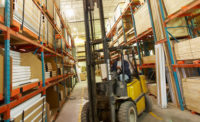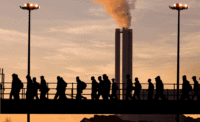Fast forward: 3 tech developments that could revolutionize safety & health

 By the Royal Society for the Prevention of Accidents (RoSPA) Training
By the Royal Society for the Prevention of Accidents (RoSPA) Training
After being gently woken by natural sunlight (courtesy of a mobile phone app), a worker fumbles for his Google Glass, which helpfully points out any hazards he might find around his home – from a stray child’s toy lying at the top of the stairs to a puddle of water on the bathroom floor – as he gets ready for work. Washed and dressed, he makes his way to the kitchen, where all electrical appliances are connected to the ‘cloud,’ ensuring they are functioning correctly and not in danger of malfunctioning, before he opens his front door and steps into his driverless car, delivering him safely to his place of work. Once there his phone and computer regularly suggest prompts for modifying his behaviour, such as adjusting his posture and taking regular screen breaks, before his self-driving car takes him back to his family at the end of the day, completely unharmed…
Is this the future of health and safety?
It sounds like science fiction, and yet the technology described in the above scenario is either already on the market or is under development. In fact, hardly a day goes by without some new technological breakthrough threatening to rewrite the rulebook as we cede ever more responsibility to gadgets and gizmos promising to protect us – all of which poses some interesting questions about the future of health and safety. With this in mind, we take a look at three of the most exciting technologies on the horizon and consider how they might one day impact on all of our lives.
Google Glass
If there is a symbol for just how far we have come since the early days of health and safety, then Google Glass is it.
Coming across like a prop from a sci-fi B-movie, in reality Google Glass is actually a relatively simple concept to grasp. Basically a pair of web-connected glasses with a small screen placed above the right eye, a video camera and an ear piece, all packaged in a range of ostentatious colors, “Glass” promises the flexibility of a smart phone while leaving our hands free.
While many have questioned the value of Glass, the product nevertheless raises a number of tantalizing possibilities. For example, could a Google Glass app be designed to trigger a warning or reminder automatically whenever a hazard is sensed? The ‘always-on’ video recording facility too would certainly help when it came to accident investigation.
However, while there are reports of surgeons and engineers having already embraced the technology, any mainstream applications will rely on Glass becoming ubiquitous. Currently quite expensive, this may be a while off yet, though with a full-scale launch planned for later this year prices will inevitably start to fall so who knows – perhaps this time next year you’ll be reading your favorite occupational safety blog on a pair of Glass!
Finally, as with all new technology it’s important that all unintended consequences – such as distracted pedestrians stepping into the road without looking – will need to be designed out before Glass can be considered truly “safe.”
Self-driving cars
Another perennial sci-fi favorite, and another project to revolutionize the world around us! However, far from a flight of fancy, many major car manufacturers have been hard at work test-driving their driverless cars on traffic filled roads around the world, with Google alone testing in America, Germany, Spain and the Netherlands.
Initially fitting their technology to existing cars, in May this year Google showcased its own vehicle – a design featuring neither a steering wheel nor pedals. Of course, a world without drivers would have a seismic impact on health and safety. Accidents on UK roads alone are responsible for around 1700 deaths and hundreds of thousands of injuries.
If the technology was proved to be safe and reliable on all situations, then driver error – a common factor in crashes – would be a thing of the past, as would accidents caused by factors such as drink driving, fatigue or texting behind the wheel.
However, before we get too far ahead of ourselves, it’s worth noting some of the barriers that stand in the path of this driverless utopia. Interestingly, for once it is not the technology that is holding back progress, but our laws – many of which date back to the time of horse-drawn carriages. Issues such as liability should a crash occur are causing law-makers the world over to scratch their heads, and with the notorious slow pace of the legal system, it may be some time before you see a driverless car on a road near you – making it all the more vital that you heed current road safety advice and take care when out on the roads!
Drones
Initially confined to military usage, drones are increasingly being touted as a solution for all manner of civilian applications. For example, online-retail giant Amazon made headlines last year when a news story broke that seemed to announce they were exploring the use of unmanned drones to deliver goods to customers.
This development has caused many in the health and safety community to wonder if there was a way the power and flexibility of drones could be harnessed in order to save lives, as David Walker, RoSPA’s leisure safety manager, explains: “It’s not outside the realms of possibility that drones could one day be used to patrol stretches of our coastlines and waterways to help identify people in trouble.” However, while it’s an undeniably exciting thought, for the time being it is important to follow the latest advice for swimming, particularly when out in open water!
Right here, right now…
Our understanding of health and safety has been transformed over the past two hundred years. While there is no shortage of new technology on the horizon that promises to change the way we think about health and safety, here in 2014 accidents are still the number one cause of preventable, premature death for most of our lives. Therefore it is important to remember that no matter what technology is currently available to us, there is no substitute for constant vigilance, personal responsibility and effective safety training.
Source: The Royal Society for the Prevention of Accidents (RoSPA) is a registered charity and the United Kingdom’s leading safety organization. Backed by our members, and inspired by our mission “to save lives and reduce injuries”, we have led the way in accident prevention for more than 90 years.http://rospaworkplacesafety.com
Looking for a reprint of this article?
From high-res PDFs to custom plaques, order your copy today!





